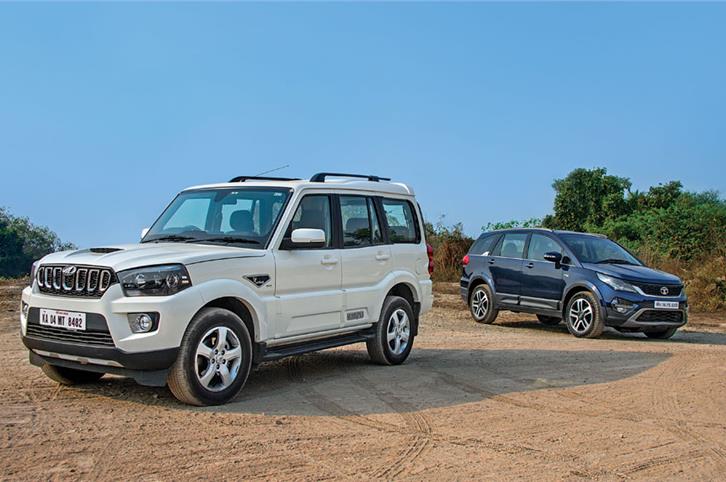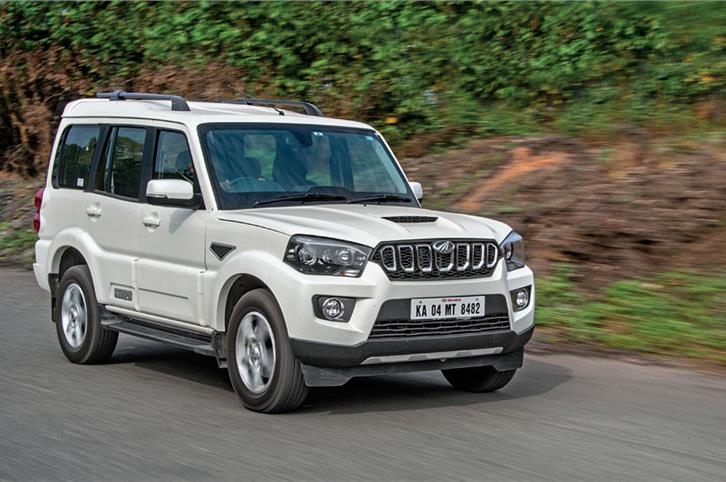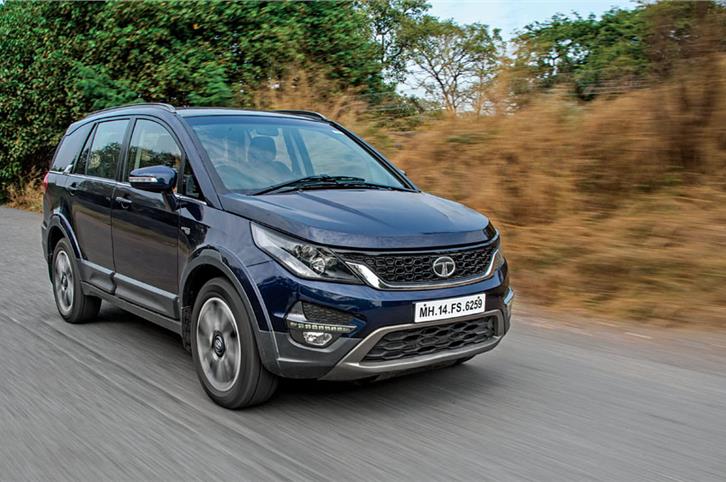We invite Tata’s Hexa to go up against the new Mahindra Scorpio to see if it is good enough to punch above its weight.
Published on Apr 09, 2018 11:54:00 AM
79,332 Views
Follow us on



The Mahindra Scorpio has been around for over a decade, now and over the years, has gained high popularity for its robust and tough build. Mahindra has done its part to keep the old warhorse relevant; and the latest update has seen the introduction of a new S11 variant that gets more power and a new gearbox. There are subtle changes to the exterior as well, in terms of its redesigned bumpers and new front grille.
This S11 variant is priced at Rs 14.78 lakh (ex-showroom, Delhi), which puts it in the crosshairs of models from a segment above; more precisely – the Tata Hexa. This feature-packed, seven-seater crossover from Tata costs a good Rs 1.2 lakh more for the two-wheel drive version; but which is the better model?
What are they like on the inside?
Inside, the new Scorpio gets rather modest updates in the form of faux-leather upholstery for the seats, gear lever and the steering wheel. The dashboard and materials remain the same as the car's previous version. You get faux-metal inserts with a dual-tone dashboard and piano-black accents for the centre console. The switches and buttons still feel a bit drab, but the chrome rings on the knobs and AC vents add a premium touch, overall. Visibility is good, too, as you are seated high up and get a good, commanding view of the road, even at the height-adjustable front seats’ lowest setting. The seats themselves are large and flat and offer decent support but you do miss the snug fit you get in the Hexa.
Coming to the second row, the Scorpio is far from disappointing. There is good space for large-framed adults in terms of headroom and legroom. It is wide enough to seat three abreast, as well. You can also opt for a captain-seat variant – which seats only two in the second row but gets dedicated seats, which are even more comfortable. The Scorpio also has a pair of seats in the last row. Labeled 'jump seats', they are placed facing each other and are quite uncomfortable on long drives and they obviously miss out on seat belts; which in this day and age, is unforgiveable. You can, however, opt for the third row to have a front facing bench seat. With the jump seats folded up, there is a good 820 litres of boot space available.
The Tata Hexa made big waves when it was launched and most of that credit went to its interior. It is a huge leap forward for Tata, in terms of design and quality. Get in and it’s surprising just how far Tata has come. The minimalistic soft-touch dashboard features dual stitching and an all-black theme, with a mix of piano black around the centre console and metal accents around the AC vents. Although the touchscreen unit feels too small, the buttons and switches have a plush feel to them. The seats and the door trims on the XT trim get premium upholstery and the steering wheel is also wrapped in leather. The seats are big and supportive and have soft cushioning, which gives the car that snug feel. Overall, space is a class up on the Scorpio. Up front the Hexa feels extremely wide. In the second row, the Hexa is even more impressive, with more legroom, headroom and width than the Scorpio. The backrest – though a task to adjust, in itself – can be reclined for added comfort, as well. The third row in the Hexa is tight, but good enough for children. Flip that, and you can have a boot space of 671 litres.
What about equipment and safety?
The Scorpio, in its S11 form, packs in quite a few goodies like a touchscreen with navigation, cruise control, rain-sensing wipers, a tyre-pressure monitor and cornering projector headlamps, amongst others. It also now gets is a reverse parking camera with park assist. In terms of safety, you just get dual airbags with ABS. The Hexa, on the other hand, is known for its extensive list of features. You get a touchscreen (which misses out on navigation), cruise control, reverse parking camera with sensors, auto headlamps, sun-blinds for the rear passengers and plenty of cubbyholes. It pips the Scorpio in terms of safety, as well, and gets six airbags, ABS with EBD, traction control, hill-hold control and hill-descent assist.
What are they like to drive?
|Fire the Scorpio’s 140hp diesel and it’s the refinement that stands out. The S11’s engine sounds more like the XUV500 now and it is more refined in the cabin than before. The responsiveness of the engine has also improved, despite a bigger turbo. There’s almost no wait before the power kicks in and you get a good punch from 1,500rpm, all the way up to 4,500rpm; and the dash from 0-100kph takes just 10.8sec – massively fast for an SUV this size. It’s even faster than the new Swift!
Engaging the gears on the new six-speed gearbox requires less effort as the gates are better defined. However, engaging the reverse takes getting used to. The newly added sixth gear is welcome, as it enhances the Scorpio’s cruising ability on highways. What makes the Mahindra relaxing to drive is the strong bottom-end, which is a huge plus when it comes to driving it in cumbersome city traffic. The Scorpio is also much faster through the gears – it attains a 20-80kph time of just 9.07sec in third gear and a 40-100kph time of 12.28sec in fourth gear, making it faster than the Hexa. Complimenting this further is the light clutch and steering that make this two-and-something-tonne-SUV rather light on its feet. That being said, the Scorpio still isn’t confidence-inspiring in corners and wallows around them. At high speeds, it feels sloppy and the ride isn’t flat either. At city speeds, though, it does ride well and tackles bad roads quite easily. Unfortunately, the brakes lack progressive feel. Though Mahindra has updated the brakes by upping the brake booster size to make the pedal pressure better, under hard braking, the Scorpio feels unsettled and dances around.
The Tata Hexa is powered by the 2.2-litre VARICOR engine that makes 156hp and 400Nm of torque. The engine is fairly silent and vibrations are well-contained. Get going though, and the sluggish nature of the engine is evident as the turbo takes time to spool up. The Hexa has drive modes (Auto, Comfort, Dynamic and Rough Road) which alter the performance, and it is best driven in Dynamic mode where 0-100kph is achieved in 14.21sec. The six-speed manual transmission is cumbersome to operate and also lacks a safety lock for the reverse gear. The clutch is snappy, too. As a result, shifting gears is sometimes jerky. Pair that to its heavy nature, and the Hexa is quite difficult to drive in stop/go traffic. On the plus side, the ride is exceptional. Even though the Hexa gets 19-inch alloy wheels, broken roads and potholes are flattened easily and only the really sharp bumps tend to register as distant thuds in the cabin. Braking, too, is much better when compared to the Scorpio. The Hexa gets disc brakes on the rear wheels as well, and they are nice and progressive. Coming to the handling, this heavy seven-seater is rather composed around the bends and has body roll that doesn’t cause any alarm. The grip levels are another aspect that impress while cornering. However, at high speeds, the heavy hydraulic steering weighs up even more.
How much do they cost?
The Mahindra Scorpio is priced at Rs 14.78 lakh (ex-showroom, Delhi) for the S11 variant. Its running cost is less and spare parts are on the cheaper side, too. So, overall, you do save money with the Scorpio. Mahindra also has a standard warranty of 2 years/50,000km which can be further extended with its ‘Shield’ programme for two additional years.
The Tata Hexa, in its XT form, is clearly more expensive priced at Rs 16.12 lakh. The Hexa is also much less efficient than the Scorpio and that only drives the running costs up. Spares are also not as cheap. In terms of warranty, you get the standard 3 years/1,00,000km, which is a relief, and you can also extend this further by up to two years/1,50,000km for just Rs 17,000 – which you absolutely should.
Which one should I buy?
The bump in power and the additional sixth gear, combined with other subtle tweaks, have made the Scorpio a much better SUV. The excellent drivability and the very strong performance has improved the fuel economy and also helped it perform better. However, power and performance were never the problem, with the Scorpio – it was more of ride, handling and comfort. In these areas, the Scorpio isn’t much improved and now it’s expensive, too.
The Scorpio was never the Hexa’s natural rival, but in the numbers game, it fell prey to the escalating price. The Hexa, on the other hand, offers everything you’d want from an SUV with that price tag. It’s spacious, comfortable, has sufficient performance, secure handling and – importantly – has a lengthy list of features on offer. The Hexa has personified Tata’s ‘more car per car’ philosophy and, hence, is the winner of this comparison.
Copyright (c) Autocar India. All rights reserved.

Maruti Suzuki plans to use the Boosterjet engine in more models. Which one would you like to see it in?
Comments
Member Login
Personal Details
No comments yet. Be the first to comment.